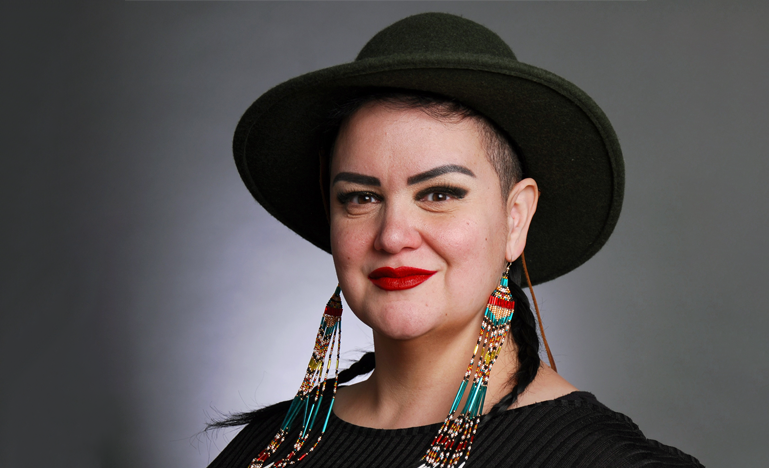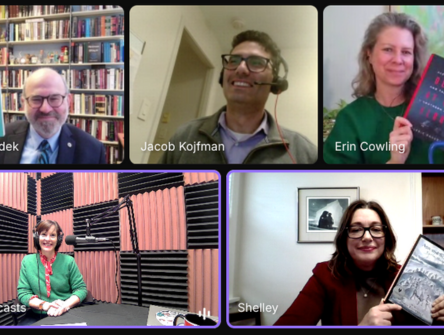A path through difficult conversations about Indigenous identity
We need to approach identity and Indigeneity in an inclusive and empathetic way. We also must carefully consider what that means for dedicated academic entrance spaces and employment opportunities.

Several weeks have passed since the CBC published its exposé questioning the Indigenous identity claims of retired Saskatchewan Provincial Court Judge Mary Ellen Turpel-Lafond. Yet the fallout from this controversy continues to make waves across the country. What's more, with the rapid proliferation of diversity, equity, and inclusion programs in the legal profession, the Indigenous identity debate should give us all pause to make sure we are giving this topic the nuanced attention it deserves.
No one can gainsay Turpel-Lafond's many contributions to Canadian law and policy through her fierce and steadfast advocacy for Indigenous Peoples, making a challenging debate over Indigenous identity even more difficult. To be clear, I take a firm position that self-identification is not a sufficient proxy for Indigeneity when defining access to ameliorative programs for Indigenous Peoples. At the same time, we must approach the issue in a way that is as inclusive as possible and be careful not to perpetuate our own self-colonization as Indigenous Peoples.
We cannot simply take the rules prescribed by the Canadian government at face value, namely those defining "Indian status" under the law, which were created to gradually erase our presence in this country. We must also avoid unintentionally contributing to lateral violence among Indigenous people, where we direct our anger and frustration at one another rather than the systems holding us back. We need to be crystal clear that there is a difference between "policing" Indigenous identity claims and protecting dedicated spaces for Indigenous people that are meant to address the harms caused by settler colonialism and systemic racism.
____________
Tackling settler dominance perspectives in law
Reconciling the contradictions in Aboriginal and Indigenous law
____________
There is an unavoidably personal aspect to someone's decision to self-identify as Indigenous. Some choose to downplay their ancestry, while others may emphasize it over other parts of their heritage and cultural connections. Nor is Indigenous identity easily distilled into a definitive test or rule. While controversial, proof of blood quantum and genealogical evidence may be necessary for some individuals to highlight how they have been impacted by colonization. These tools may help them in their journey to reclaim who they are as an Indigenous person.
Other tools for proving Indigeneity, like the status cards issued to First Nations people by the Government of Canada, can be both useful and problematic. They reflect genealogical connections, but a status card alone does not mean someone is accepted by any Indigenous nation to which they are related. The rules governing status under the Indian Act are also a poor match for how Indigenous people define kinship and citizenship through their laws and practices.
Many individuals have limited connections with Indigenous communities and cultures precisely because settler colonialism, policies, laws, and actions intentionally weakened our cultural and community ties. Forced attendance at residential and day schools separated Indigenous children from their families and communities over successive generations. The Sixties Scoop sent Indigenous children in large numbers into adoption by non-Indigenous parents. Others settled in urban environments to escape poverty or domestic violence, breaking ties with their home communities for themselves and their children. We need a framework for identity that takes a more thoughtful approach than simply questioning who is "Indigenous enough" to self-identify based on the stereotyping or idealization of Indigeneity.
There is a limited supply of dedicated academic entrance spaces, scholarships, and employment opportunities for Indigenous individuals. Several years ago, I was asked to create a model policy for a national identity standard for law school admissions and programming across Canada. Working with the Indigenous Law Centre at the University of Saskatchewan on the proposal, we characterized these opportunities as "settler harm reduction spaces."
It is worth asking what we hope to accomplish when we create these spaces. Are our goals being met if these spaces are disproportionately taken up by individuals who have faced few, if any, of the barriers to accessing a legal education that disproportionately afflict Indigenous people? If not, how can we adjust course to ensure those goals are met?
We argued that accessing dedicated ameliorative programming for Indigenous Peoples requires some evidence beyond self-identification. Something more is needed to show that an applicant has been adversely affected by settler colonialism, whether through the intergenerational trauma of the residential schools, child apprehension, poverty, or one of countless other reasons. If those programs are meant to address the discrimination and impacts of colonization that Indigenous people face, it seems reasonable to ask that applicants connect themselves to the goals of those programs beyond just checking a box.
So we argued that Indigenous communities should have a voice in deciding who gets to access dedicated spaces. After all, they can decide who they claim as their own. Meanwhile, we must be sensitive to the individuals who no one claims precisely because of how settler colonialism has affected them and their families. There is a role for valid government identification in this process, such as status cards. Other useful evidence could include letters from community Elders or proof of membership in a legitimate Métis organization.
When discussing something as personal and heated as Indigenous identity, it is essential to stay as factual as possible and steer clear of the mud. My philosophy has always been to help others identify the parameters of current debates without imposing my views on them. If you bring a horse to water, even if they don't drink, they should at least start to think about why they are refusing to do so.
Many Indigenous women, in particular, continue to live with the real-time consequences of colonial harm. Intergenerational traumas exacerbated by poverty and daily microaggressions of racism still take their psychological and physical toll on us. In many professions, law included, Indigenous women often carry a litany of untold stories about abuse and racism they never share with their non-Indigenous colleagues.
I believe this is why the CBC's investigation into Turpel-Lafond's background and upbringing has sparked the most outrage from Indigenous women in the professions and academia. Reports strongly suggest she led a privileged childhood and relied on an unsubstantiated family story to identify as Indigenous in a very public way from early on in her professional life.
Understandably, Turpel-Lafond has the support of her family and friends to identify however she pleases. Because of her marriage into an Indigenous community, her story has another layer to it that also muddies the debate. However, there are still important questions that the public and the profession need to work through. What would Turpel-Lafond's legal career have looked like if she did not self-identify as Indigenous in a very public way early on? For example, would she have been appointed to the Provincial Court in her mid-30s? Would she have the same standing and opportunities as a long-standing ally to Indigenous Peoples if she had never claimed Indigeneity for herself?
Indeed, there is also a limited number of informal accolades to go around, as when we celebrate new "firsts" for marginalized groups, including Indigenous people. Hearing news that another glass ceiling has been shattered is powerful medicine for anyone struggling to heal from settler colonialism. But what do we do when someone claims a false first? What does it say to those of us who carry all the wounds of Canada's failed attempts at assimilation when it turns out that someone we looked up to was claiming harms they have never known?
Turpel-Lafond is quoted in the CBC article as having claimed she was the "first Treaty Indian" to be appointed to the Provincial Court of Saskatchewan. If indeed Turpel-Lafond has no claim to Indigeneity from this settler harm reduction lens, who then would have been the first Indigenous judges in Saskatchewan?
"Race shifting," "pretendianism," "box-checkers" – no matter how this phenomenon is characterized, it has proven to be incredibly harmful. Not just to the Indigenous people who look the way Hollywood tells us they should look, but to those who do not. For example, Black or fair-skinned Indigenous people must now bear the brunt of the renewed suspicion, lateral violence, and exclusion that this debate stirs up. The very public controversy around the identity claims of Turpel-Lafond, like Carrie Bourassa, Michelle Latimer, Joseph Boyden, and others before her, acts as an accelerant to the harms and microaggressions that light-skinned Indigenous people face. While fair-skinned Indigenous people like myself undoubtedly benefit from white privilege in many instances, we are often met with skepticism when we identify as Indigenous in the spaces where Indigeneity is seen as an asset rather than a cross to bear. The perception that we are somehow "diluted" in our lived experiences as Indigenous people can lead to shaming and exclusion within our communities.
Of course, there are benefits to white privilege. You have some control over who perceives your Indigeneity in a sense. You can avoid the daily microaggressions that those who are visibly Indigenous or otherwise racialized must constantly contend with. As a young child, I rarely suffered those indignities, except when I was quickly made aware of the microaggressions that happened all the time by spending time in public spaces with my visibly Indigenous mother and other family members. As an adult today, I am not followed around when shopping in stores, and I can usually relax in restaurants. But I face the painful experience of seeing the microaggressions my daughter has to contend with daily because of her brown skin, even though she is not being raised in poverty like I was.
The point is that those of us who are fair-skinned are still raised in a very different family environment when one or both of our parents are not seen as white by others. We have empathy for our parents' struggles embedded in our lived experiences and inseparable from who we are. Likewise, microaggressions are just one element of the deeply rooted systemic racism that oppress Indigenous people, both individually and intergenerationally, burdening us with poverty and other forms of marginalization that together form almost insurmountable barriers to success.
As challenging as defining Indigeneity, it should be clear that those who have never been humiliated by these microaggressions and have never experienced systemic oppression ought not to have a valid claim to ameliorative programming or accolades for breaking down barriers. Those whose self-identification as Indigenous is only informed by family lore are perpetuating an elite capture of the spaces and honours meant for those suffering and struggling against marginalization and oppression. When someone with a privileged upbringing claims false firsts based on an identity claim, they set an impossible standard of success for those trying to find success while healing from trauma and fighting against racism in their lives.
It was only in 2018—two decades after Turpel-Lafond's appointment—that Mary McAuley, Natasha Crooks and Michelle Brass were appointed to the Provincial Court. Judges McAuley and Crooks are both Métis, and Judge Brass is a member of Peepeekisis First Nation. Gerry Morin, a member of Peter Ballantyne Cree Nation, appears to have been the first Cree-speaking judge, and may have been the first and only First Nations judge in the province when he was appointed in 2001. Judge Kenneth Bellerose was appointed to the Saskatchewan Provincial Court in 1977, making him the first Métis judge in this province by a long shot. If we want to see the profession's glass ceiling shattered for good, we may want to turn our attention to the barriers they faced in making their way to the bench.
Judging the evidence
Being at the centre of the Indigenous identity debate must be extremely difficult for Turpel-Lafond and her family members. Some commentators are treating her father's birth certificate as "smoking gun" evidence that she falsely claimed Indigeneity early in her career. But a birth certificate is by no means the final word on Indigeneity. My maternal grandmother came from a large family and had many siblings. In the face of extreme poverty, she was married as a child to a white man in his 30s, although in the past, that age for marriage was considered acceptable. The man was a horrible brute, and after some years, she fled the domestic violence with her two young daughters in tow, escaping back to her father's house near Wakaw, Saskatchewan. There she met another man—one with whom she ended up living as his common law spouse for many years in his home community of One Arrow First Nation. When my mother was born, the nurses at the hospital told my grandmother that it would be better to write her former husband's name as the father on my mother's birth certificate as it was less "Native-sounding ."
When it came time to apply for my Indian Act status, I was initially prevented from doing so because my mother's birth certificate was wrong. Even having band council resolutions address the Indigenous paternity of my mother was not enough for Indian Affairs. Nor was it enough for many of our relatives to write letters on our behalf, including an aunt who had served as chief of One Arrow First Nation. I had to find another way to correct that error, which ended up being a DNA test that provided incontrovertible evidence that we were biologically related to our family from One Arrow.
As any legal professional worth their salt knows, we must look at the evidence together as a whole. What evidence has been provided to counterbalance the birth certificate, the voting records of her parents, the school yearbooks from Niagara Falls, among other examples surfaced by the CBC? We are left with self-identification alone. We have yet to hear anyone from Norway House Cree Nation come forward to claim Turpel-Lafond or her father as their own. So where does the burden of persuasion fall in this case? If all available evidence suggests one inference, anyone who wishes to assert the opposite will have a steep hill to climb. While I have struggled against this burden of persuasion myself, I was able to dispute an inaccurate birth certificate with a DNA test that tied me to my living, direct family members and those family members always claimed me as their own.
I also want to comment on the stereotype that white women marry status men for the sake of the scarce benefits offered by status under the Indian Act. It is a narrative driven by misogyny, conscious or otherwise. Admittedly, non-Indigenous women who married First Nations men with status under the Indian Act prior to an amendment in 1985 became eligible themselves, and secured this for their children. However, it beggars belief that white women would marry Indigenous men for status alone. The ones I know have done so out of love. And many of them see themselves as advocates for Indigenous Peoples as a consequence of how their relationship connects them to these concerns. This does not excuse those individuals who take this beyond allyship by trying to recast themselves as Indigenous, but it may make us more understanding of how these lines were blurred in past generations.
My anti-dominance research explores how all of us, settlers and Indigenous people, are victims of colonialism. And the effects of our victimization fall along a spectrum of dominance. Total subordinate marginalization falls at the far end of this spectrum, and privileged domination falls at the other extreme. Where we "slide" along this spectrum, which is informed by our own individual lived experiences, will be different for each and every one of us. So much more than race goes into the lived experiences that make us who we are.
What is important to remember is that Indigenous Peoples have the same right to self-determination as any other people under international law. This means we must let each Indigenous nation and community determine for themselves who they claim as their members, citizens, or kin. We must also bear in mind that some of those who self-identify as Indigenous, even when accepted as such by an identifiable Indigenous nation or community, have far more in common with the dominant "haves" on this spectrum of victimization. If so, what need do they have for access to the settler harm reduction spaces meant for those struggling at the far end of this spectrum of subordination?
The whole premise of anti-dominance is to find empathy for each other, in spite of our differences. It is easy to condemn others for what they say and how they act, such as those that seem to claim Indigeneity in a self-interested way. But an anti-dominance framework directs us to work productively through those differences. Such empathy is often confused with weakness. But it is our best guide for how to find a path through difficult conversations, including the important questions around Indigenous identity and false firsts. Ekosi.


